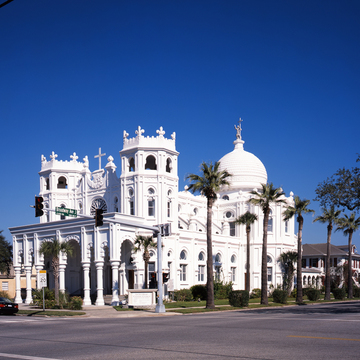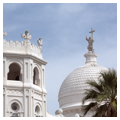The institutional landmark of the East End of Broadway (what the Galveston Daily News in the 1880s called the “castle district”) is Sacred Heart Catholic Church, built to replace a larger, more ornate, and more accomplished French Romanesque–style predecessor by N. J. Clayton of 1892, destroyed in the Storm of 1900. Designed by a Spanish Jesuit lay brother, one of a team of Jesuits who had collaborated with Clayton on the construction of large churches Clayton designed for the order in Macon, Georgia, and Tampa, Florida, the church appears both exotic and overwhelmingly white. Its exoticism derives from Jiménez's architectural naiveté; the historical source for his awkward but engaging design was identified at the time of the church's dedication as the Puerta Santa María in Toledo, Spain, built in the thirteenth century as the Grand Synagogue of Toledo. The building's whiteness outside and inside accentuates this exoticism, since the stucco-faced, concrete church seems to glow in the intense radiance of Galveston's sunlight, offset by the file of slender Washingtonia palm trees lining the Broadway frontage. Clayton replaced Jiménez's original dome with an onion dome that possesses the spatial tautness and architectural authority the church otherwise lacks.
You are here
Sacred Heart Catholic Church
If SAH Archipedia has been useful to you, please consider supporting it.
SAH Archipedia tells the story of the United States through its buildings, landscapes, and cities. This freely available resource empowers the public with authoritative knowledge that deepens their understanding and appreciation of the built environment. But the Society of Architectural Historians, which created SAH Archipedia with University of Virginia Press, needs your support to maintain the high-caliber research, writing, photography, cartography, editing, design, and programming that make SAH Archipedia a trusted online resource available to all who value the history of place, heritage tourism, and learning.


















